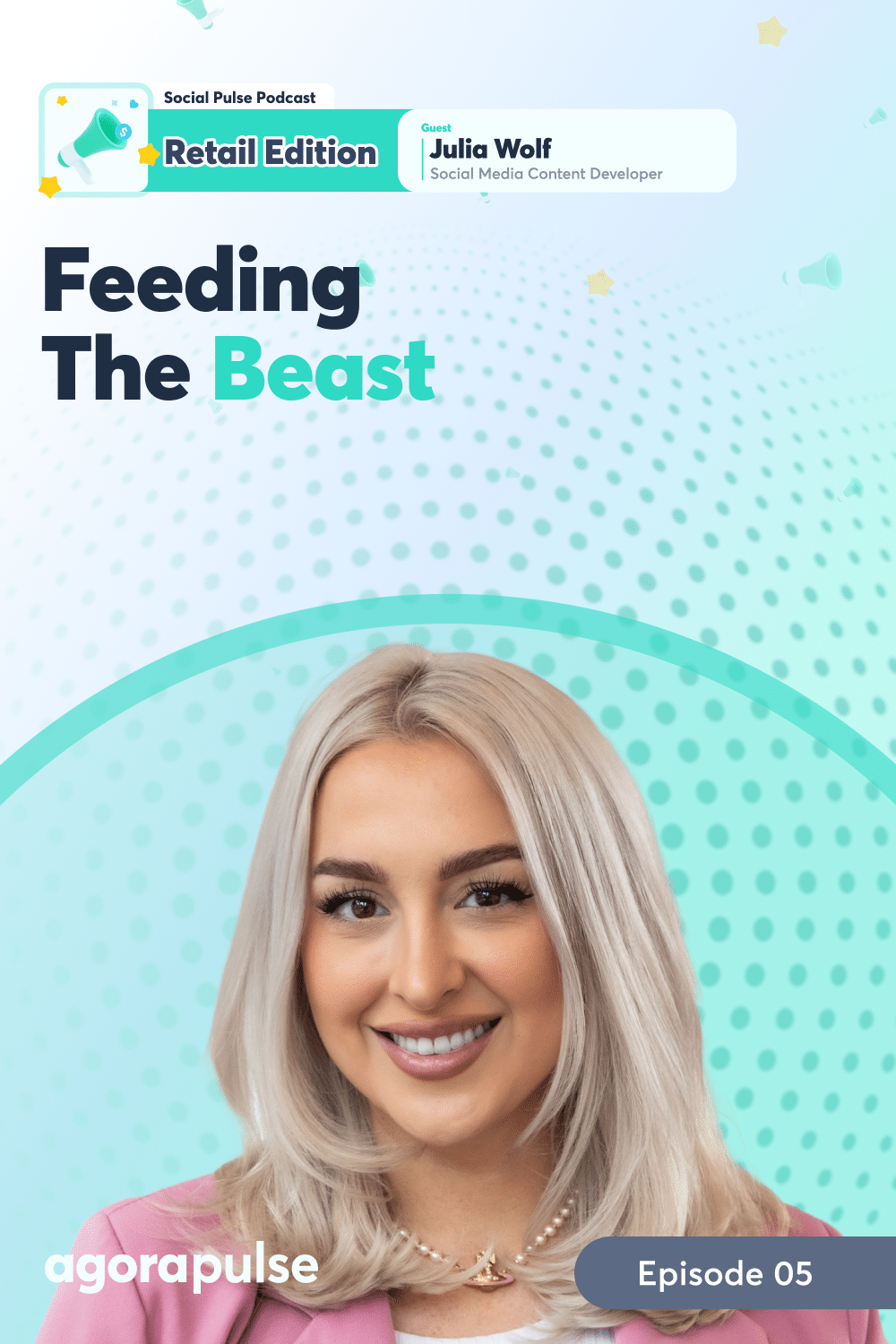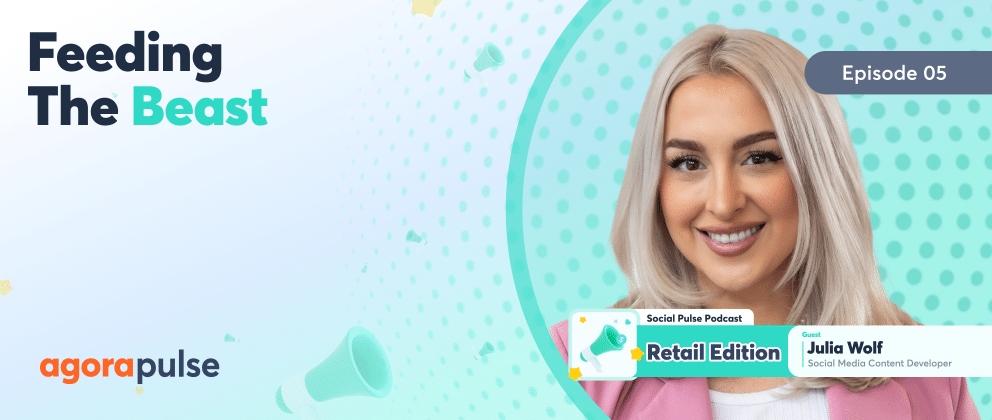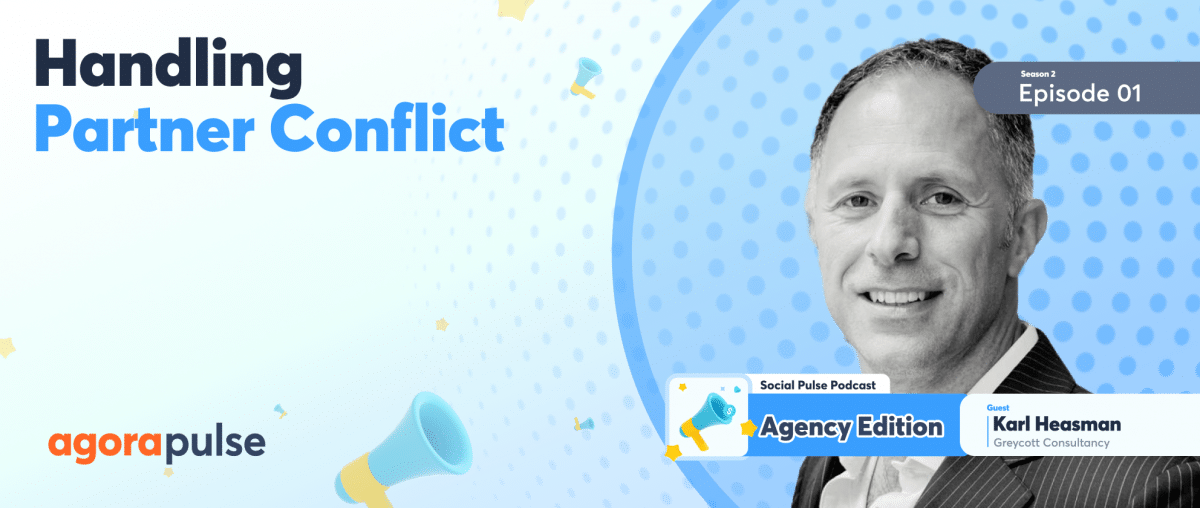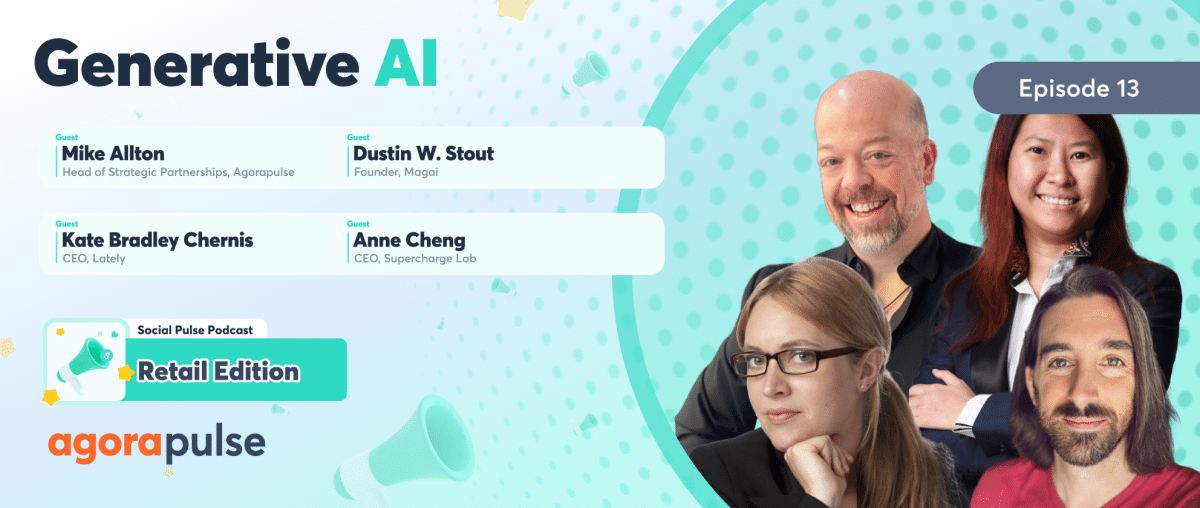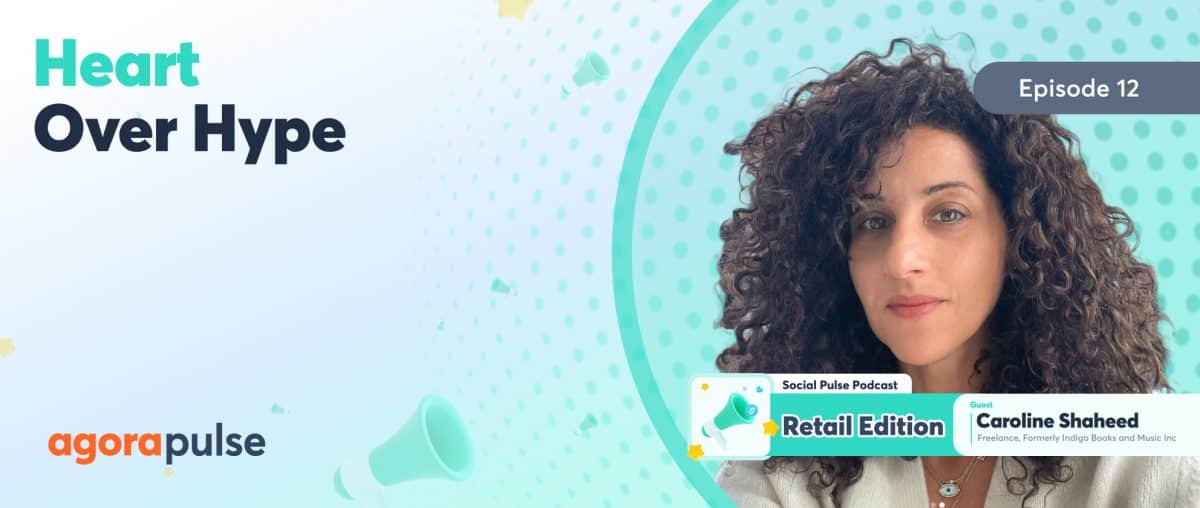For retail brands, posting on social media once a week is not enough. In fact, that’s such a ridiculous idea that you probably laughed a little to yourself when I suggested it. Or you may have cried a little, too, because it’s true! Retail brands have to be active in publishing regularly at a far higher rate than other industries.
And it’s not enough to just spam edited product images, is it? Audiences want to be educated and entertained, which means we have to create a lot of engaging content. How do we keep feeding the beast of social media, while at the same time maintaining high levels of creativity and engagement?
That’s exactly what social media content developer Julia Wolf of Five Below is going to talk to us about in this episode of Social Pulse Podcast, hosted by head of Strategic Partnerships, Mike Allton. You can listen to the whole episode below or read on for highlights.
With seven years of in-house and agency design and social media experience, Julia has worked to produce creative solutions for a variety of clients ranging from small nonprofits to large fortune 500 companies. Julia now serves as the social media content developer at Five Below. Since joining the company in July 2022, she’s contributed to the brand’s rapid social media growth, creating content for Facebook, Instagram, and TikTok.
Getting Started: What Is Five Below?
Julia Wolf: Five Below is an American chain of specialty discount stores whose prices are mostly $5 or less, and we have a new section called Buy Beyond where prices can go up to $25. Our motto is, “Let go and have fun.” We have about 1,500 stores, and within those stores we have 10 worlds.
There’s a bunch of different products. Some of our more popular worlds are party, style, and beauty. We have room and tech. There’s lots of different products that we need to post on social media because of this, my day-to-day looks different every single day.
For example, I can give you an example of a recent day I had: I started the day. Let’s say I was doing cowboy-inspired fashion and the spring in-store launch. I have to do my own hair and makeup and get camera-ready. And then I go into the office, style my set. I set up the lighting, set up the camera, shoot for about an hour, hour and a half. Then I take lunch, and then I go downstairs—we’re right above a Five Below store—and I’ll shoot some in-store content. I will go on my computer, find some stock music, and I’ll spend the rest of the day editing the videos.
Mike Allton: We’re definitely going to dig into that. I have a daughter who’s 12. She loves Five Below. She loves going there for perfumes, which is great because she’s not asking me to spend an outrageous amount of money on something that she’s going to go through in a week. So, I love that.
Content Creation
When you’re creating content for social media, what does that typically look like to you, coming from a B2B SaaS company? Like with Agorapulse, more often than not, my posts are simple link shares with copy. I gather that’s not what you’re sharing.
Julia Wolf: Creating content can look like a number of things for Five Below. We do all types of videos.
For example, we found something that works really well is a UGC style, like an in-store haul type of video. Sometimes, it’s as simple as showing the product on the shelf. I think it works well because it gives customers sort of a point of view and puts them in the store, and it shares the store experience with them.
This works well for something like collectibles or plushies, but the style of content doesn’t work well for things like makeup. So when you’re showing makeup, you want to show people a swatch, or you want to show how it lays on your face. And for that, you need to be on camera. So we flipped the switch and turned into beauty influencers.
Every day can really be a new challenge.
Mike Allton: Oh, that’s fascinating. I was talking to one of TikTok’s product managers last month for a retail summit that we did at Agorapulse, and she was covering a lot of these same points that you just made, that particularly on TikTok, about how UGC-looking content is outperforming everything else—and I say “looking” because it’s not necessarily actually user-generated content.
Some of the content that you’re creating is that style, but you’re the one creating it, the brand. You’re not necessarily using users.
Challenges of Content Creation
Mike Allton: Now, with over 1500 locations, as you said, tons of products are a lot of potential content and posts to be made.
What are some of the initial challenges you faced?
Julia Wolf: We face all sorts of types of challenges at Five Below.
One example that we face is an annual challenge, and it’s the summer content. So, when I first started at Five Below, we didn’t have a dedicated social team or strategy, so I would piggyback off the seasonal campaign shoots. The summer shoots would typically take place in early March, and it’s cold in Pennsylvania during that time.
So, last year, we did our social shoot in Palm Springs, California. We had four days to shoot content, and all of our products had to be FedEx out west. Between the three teams, we had to share everything. So we have the paid social, the organic social, and the still photography shoots.
With the amount of posts that we had on the social media calendar, I was waking up at 5–6AM planning my shoot for the day. We would shoot all day, go back to the hotel, and plan for the next day. It was probably one of the most difficult and exhausting things I’ve ever had to do, and with all of that, I still didn’t manage to get all the content that I needed.
How are you catching up and creating even more content today? How are you solving those kinds of challenges?
Julia Wolf: We actually don’t have social media shoots anymore. We now have a social media manager, we have another content creator, and we work with an agency, so we have the capabilities to get content done on a more case-by-case basis. This has been working a lot better and has shown us better results, and it was a no-brainer because shoots are really expensive, and we actually save a lot of money by doing this.
Turns out that people weren’t really responding, as well to that photoshoot content. And I suspect it’s because it didn’t appear organic. Everything was staged. And so people didn’t connect as much. They really liked that organic style of content.
Mike Allton: That makes a lot of sense.
That reflects what the TikTok product manager told us. Even in our last episode, we were talking with JCPenney’s social media manager, and she was saying a lot of the exact same things. We were comparing and contrasting the old JCPenney’s catalogs that all had highly stylized photo shoots and really professional product photos to today. It’s a lot of literal UGC content or off-the-cuff content. She’ll walk into a store, like you’re talking about with Five Below, and take a lot of imagery herself.
That really obviously seems to be the way that audiences are resonating with content today.
And she actually gave a lot of props to Gen Z for forcing this change and how brands perceive social media and trying to drive us as the brands to be more authentic and organic in how we’re using social media.
Internal Strategies and Influencer Marketing
Mike Allton: Julia, can you share with me some more examples of how you’re creating content for social media, how it’s being posted out, what’s happening next?
What are some examples of these tactics that you’re using?
Julia Wolf: Sure. So, now that we post on a more case-by-case basis, it allows us to shoot closer to the season that we’re posting in.
It also allows us to hop on those trends a little bit more timely. Summer’s warm in the PA, so we’re able to go outside and shoot that picnic scenario that we may need to shoot.
It also has been a huge weight off of my shoulders now that we have another content creator, Catalina Lubin, to help me. She not only can shoot some content alongside of me or by herself, but she offers a totally new perspective that I wouldn’t have originally thought of.
Additionally, we are now working with an agency who can facilitate some influencer content. So recently we worked with Zachariah Porter and Bethenny Frankel.
Some of our content creators live near the ocean, or they have a pool, and this is perfect for those things like pool inflatables that we can’t necessarily shoot in Philadelphia. This is a perfect solution for summer products that we would struggle to make into a compelling piece of content.
Mike Allton: You’ve got internal strategies and help, which is really important. But I also love that you’re working with specific influencers where you’ve identified that because of. The nature of who they are, where they are—they’re able to address a segment of the audience or a segment of your products or both a little bit differently than you are.
And you’ve seen success with working with those influencers?
Julia Wolf: Yes, definitely. It is great working with influencers, and I’m sure our audience may get tired of seeing me on the camera all the time.
I love working with influencers and content creators, and I love seeing their content because you never know what it’s going to be.
Mike Allton: Well, you’re great on camera, but I can also attest to that change of pace being necessary. I know as an event producer, it’s important to have different voices so that people hear those different voices. And the same thing goes for your social media presence and your advertising. We want to see different people who could potentially relate to in different ways.
How are you measuring the success of your own social media activity?
Julia Wolf: All right, so we now have a social media manager. Her name is Amanda Luvera, and she leads the charge in social media analytics in partnership with our agency.
There are a few ways to measure impact, such as impressions and engagement rate. We typically shoot for a 1.5% engagement rate, and we exceed that often.
For example, I just posted a strawberry obsession video, I think it was last week, and it has a 95% engagement rate on TikTok and a 10.21% on Instagram. One of the big statistics that we shared in a recent town hall is that we now have 3.3 billion views on hashtags #fivebelow and #fivebelowfinds.
@fivebelow we know you want strawberries. so here, have some strawberries 🍓🥰 #fivebelowfinds #strawberries #strawberryfinds ♬ Get Ready – SUPER-Hi & NEEKA
Tech Stack
What’s in your tech stack at Five Below?
Julia Wolf: I have a few different tools that I love to use. I actually edit all of my videos on CapCut on my phone. So, I’ll take all the video on my phone and edit it all on my phone, and then I’ll AirDrop it to my laptop.
Two of the stock music accounts that we like to use are Artlist and Envato Elements. I think they both offer different types of music, and I like using them both.
And I think the most important and impactful tool that we use is Airtable. When I started working at Five Below, we had our social media calendar in an Excel doc. The Excel doc was so big that it would crash my computer, and it was combined with all of this other information, and I really give props to the girls that were managing it because that thing was a behemoth. But now we wanted to switch to something that was an actual calendar, so we use Airtable. Airtable gives us the ability to tag each other, to leave comments, to change the status of our post. It really just gives us an all around good communication tool, and it gives everything at a glance. My life has just improved so much.
Mike Allton: That’s a great shout out for Airtable. I know a lot of community managers that have used them.
We use Asana here at Agorapulse for our projects. So we’re not still using it for social media, but I do recognize the power of having that collaborative tool where you can see posts, projects, tasks, whatever it is that you’re working on together as a team and comment on them, easily change the status with a toggle, and move them around different boards.
Trends
Mike Allton: Now, earlier you mentioned trends. And I know that’s a really hot topic for social media managers, particularly in retail, because it’s hard to keep up with not only changes to the platform, but what’s trending, what’s not, what are best practices today.
What are you using, or who are you following today to help you keep up with these kinds of things?
And these could be blog posts, podcasts, newsletters, individuals, you know, whatever’s top of mind for you.
Julia Wolf: Yeah, so, our agency actually has this trend-spotting feature that they offer us, so they have our team’s channel, they have a trend spotting team’s channel, and they’ll share what trends that they found that they think would be applicable to Five Below.
So we’ll look through these and be like, “yes,” or “this one, no,” or “that one doesn’t work,” and we’ll find our own way to create them. And then also amongst the social media team, we have our own little trend-spotting. So my For You page looks totally different from my co-workers’ For You page. I like to share what I see, and they share what they see, and we all laugh about it, then we see who’s will make a good Five Below post.
One content creator that I really like: His name is Bran Flakezz (@bran_flakezz), and he’s actually a local Philadelphia content creator. He gives great tips on how to create social media content that is engaging, and most recently he did a storytelling post where he taught how to tell a story on content and keep people engaged from start to finish.
And this is really important when you’re creating long-form content. And last but not least, I’d say, just follow other brands. I really like to follow Scrub Daddy, Duolingo, and Taco Bell. Five Below really likes that snarky, brand voice, and we really love watching their content and taking inspiration from it.
Thank you for listening to another episode of Social Pulse Podcast: Retail Edition, hosted by Mike Allton and powered by Agorapulse, the number one rated social media management solution. If you enjoyed this episode, please subscribe on your favorite podcast player, and be sure to leave us a review. Your feedback is important to us.
